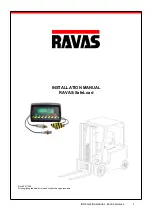
42
Chapter 7 Maintenance
7.1 Daily Maintenance
1. It is necessary to arrange professionals for care during the charging operation,
especially when the battery is almost fully charged; make sure that the plug and the
socket are in good contact during the charging process to ensure that the charging
device works normally and ensure that the connection points of the battery pack are in
good contact. If an abnormality occurs, the battery needs to be repaired before
charging;
2. Check the battery voltage, temperature, voltage difference, etc. displayed on the
circular display meter before charging and discharging to ensure that all values are
within the normal range;
3. If there is a large amount of dust, metal shavings or other debris on the upper cover
and poles of the battery pack, use compressed air or dry cloth to clean it in time, avoid
cleaning with water or water-soaked objects;
4. When charging and discharging, try to avoid water or other conductive liquids
splashing on the top cover and poles of the battery, for example, being exposed to
heavy rain during use;
5. Estimate the charging time and discharging time of the battery according to the
actual status of use of the battery or battery pack, observe whether there is any
abnormality in the battery or battery pack at the end of charging and the end of
discharging, such as the voltage difference of the battery.
7.2 Regular Maintenance
1. Check the nodes such as the conductive strips and voltage collection terminals for
looseness, shedding, rusting or deformation, etc., to ensure that the series-parallel
harness used in the battery pack is firm and reliable (once a month);
2. Check the battery casing for cracks, deformation, loose poles, bulging and other
abnormal conditions (once a month);
3. Check the reliability of the charging device to ensure that the charging device
performs the charging action in accordance with the voltage regulation and current
regulation signals sent by the BMS and to ensure that the battery will not be
overcharged (once a month);
4. Check discharge protection equipment, such as fast-acting fuses, DC contactors,
relays, etc., to ensure that the battery pack can be quickly disconnected from the main
circuit in the event of a dangerous situation such as short circuit or overcurrent (once
a month);




















